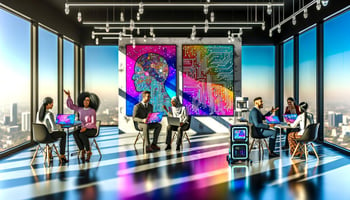Blurring the Lines Between Art and IT In today's dynamic technological landscape, the boundaries...
Artistic Expression in IT: Enhancing Business Agility

Artistic Expression in IT: Enhancing Business Agility
Blurring the Lines Between IT and Art
In the constantly evolving world of technology, the concept of IT as a purely technical domain is rapidly shifting. The fusion of art and IT is emerging as a powerful paradigm, allowing businesses to rethink their IT architecture not merely as a functional necessity but as a form of artistic expression. This approach not only fosters innovation but also enhances business agility and financial returns.
Viewing IT architecture through the lens of art transforms the traditional processes, inviting creativity, imagination, and a break from conventional norms. This reimagining of IT encourages a holistic problem-solving approach, where technology solutions are not only functional but also aesthetically appealing and engaging. This artistic mindset nurtures an environment where unique, inventive solutions can flourish, ultimately driving business success.
The intersection of IT and art brings about a transformative opportunity for organizations. By leveraging the principles of artistic expression, businesses can develop systems that are intuitive, adaptable, and user-centric. This integration elevates IT from a mere operational tool to a strategic asset that can inspire and empower both users and organizations.
Reimagining System Design with Creativity
Reimagining system design as a creative process can unlock unprecedented opportunities for businesses. The creative process in art involves experimentation and the courage to break boundaries—qualities that can be directly applied to IT architecture. When IT professionals adopt an artistic mindset, they are more likely to discover innovative solutions that blend functionality with creativity.
This creative perspective fosters a more comprehensive approach to problem-solving. IT professionals are encouraged to think outside the box, resulting in systems that are not only efficient but also emotionally and intellectually engaging. By embracing creativity in system design, businesses can develop solutions that are both technically sound and artistically resonant.
Moreover, this creative approach to IT design allows businesses to align their technological infrastructure with their strategic goals more effectively. By treating system design as an art form, companies can create a more cohesive and engaging user experience, ultimately leading to increased satisfaction and productivity.
The Synergy of Art and Technology in User Interfaces
Art and technology have long shared a symbiotic relationship, each influencing and enhancing the other. This synergy is particularly evident in the design of user interfaces, where artistic principles are leveraged to create more intuitive and engaging experiences. By incorporating elements of color theory, composition, and visual storytelling, IT professionals can design interfaces that are not only functional but also aesthetically pleasing.
This artistic approach to user interface design significantly enhances usability and engagement. By creating interfaces that resonate on an emotional level, businesses can improve user satisfaction and increase the overall effectiveness of their technology. The fusion of art and technology in user interfaces demonstrates the potential for artistic expression to drive innovation and success in IT.
Incorporating artistic elements into user interfaces also allows businesses to communicate complex information more effectively. By leveraging visual storytelling, companies can create interfaces that are not only easy to navigate but also provide context and meaning to user interactions. This approach fosters a deeper connection between users and technology, leading to improved user experiences and outcomes.
Leveraging Metaphor and Narrative in IT Solutions
The use of metaphor and narrative in IT solutions offers a powerful way to create more cohesive and engaging experiences for users. By viewing systems as stories, IT professionals can design more intuitive and meaningful interactions, helping users navigate complex systems with ease. This narrative approach provides context and significance to user interactions, enhancing overall satisfaction and productivity.
Metaphors in IT design allow for more relatable and understandable systems. By drawing parallels between familiar concepts and technological processes, businesses can create solutions that are easier for users to grasp. This approach not only improves usability but also fosters a deeper connection between users and technology.
Furthermore, incorporating narrative elements into IT solutions encourages adaptability and flexibility. By designing systems that are dynamic and evolving, businesses can respond more quickly to changing needs and opportunities, enhancing their overall agility and competitiveness. This narrative-driven approach to IT design reflects the potential of artistic expression to drive innovation and success in the digital landscape.
Case Studies of Art-Inspired IT Success
Several companies have successfully integrated artistic principles into their IT strategies, achieving remarkable results. For example, a boutique IT consultancy firm reimagined their system architecture as a dynamic, ever-evolving artwork. By doing so, they were able to create a more agile and responsive IT infrastructure, resulting in increased efficiency and reduced costs.
Another example is a global technology company that used principles of minimalist art to streamline their user interface design. By focusing on simplicity and clarity, they were able to enhance user satisfaction and reduce training costs. This approach not only improved the user experience but also increased the overall efficiency of their systems.
These case studies demonstrate the power of art-inspired IT solutions to drive business success. By embracing artistic principles, organizations can create systems that are not only functional but also innovative and inspiring. This artistic approach to IT design fosters a culture of creativity and innovation, ultimately leading to improved business outcomes.
Maximizing Agility with Creative IT Strategies
In today's fast-paced business environment, agility is key to success. By adopting creative IT strategies, businesses can enhance their agility and responsiveness, enabling them to seize new opportunities and navigate challenges with ease. Artistic expression in IT can play a crucial role in fostering this agility.
Creative IT strategies involve rethinking traditional approaches to system design and implementation. By embracing an artistic mindset, organizations can develop more flexible and adaptable IT solutions that can quickly respond to changing needs and opportunities. This approach encourages experimentation and innovation, leading to the development of more effective and efficient systems.
By integrating artistic principles into their IT strategies, businesses can create a more agile and responsive IT infrastructure, enabling them to thrive in an increasingly competitive and dynamic market. This focus on creativity and innovation allows organizations to develop IT solutions that are not only functional but also inspiring and engaging.
Integrating Innovative Tools for Artistic IT Execution
Innovative tools play a crucial role in executing artistic IT strategies. Advanced technologies, such as artificial intelligence and machine learning, can be leveraged to create more sophisticated and responsive systems. These tools enable IT professionals to experiment with new ideas and approaches, leading to the development of more innovative and effective solutions.
For example, AI-powered design tools can help IT architects explore new design possibilities and create more intuitive and engaging user interfaces. Machine learning algorithms can be used to optimize system performance and enhance user experience, resulting in more efficient and effective IT solutions.
By embracing innovative tools, businesses can unlock new possibilities for artistic expression in IT, leading to the development of more creative and effective systems. This focus on innovation and experimentation allows organizations to stay ahead of the curve and maintain a competitive edge in the digital landscape.
Overcoming Challenges in Artistic IT Implementation
While the integration of artistic principles into IT strategies offers significant benefits, it also presents unique challenges. One of the primary challenges is balancing artistic expression with technical requirements. IT professionals must ensure that their artistic vision does not compromise the functionality and reliability of the system.
Another challenge is managing the complexity of artistic IT solutions. Artistic expression often involves experimentation and iteration, which can lead to increased complexity and risk. IT professionals must carefully manage this complexity to ensure the successful implementation of artistic IT solutions.
To overcome these challenges, businesses must foster a culture of collaboration and innovation. By encouraging open communication and collaboration between IT and creative teams, organizations can develop more cohesive and effective IT solutions. Additionally, by prioritizing user-centric design and focusing on the needs and expectations of users, businesses can create systems that are both artistic and functional.
By embracing artistic expression in IT, businesses can unlock innovative solutions that enhance agility and drive financial success. This approach fosters a culture of creativity and innovation, allowing organizations to develop IT solutions that are not only functional but also inspiring and engaging. As technology continues to evolve, the integration of artistic principles into IT strategies will become increasingly important, enabling businesses to thrive in an ever-changing digital landscape.



